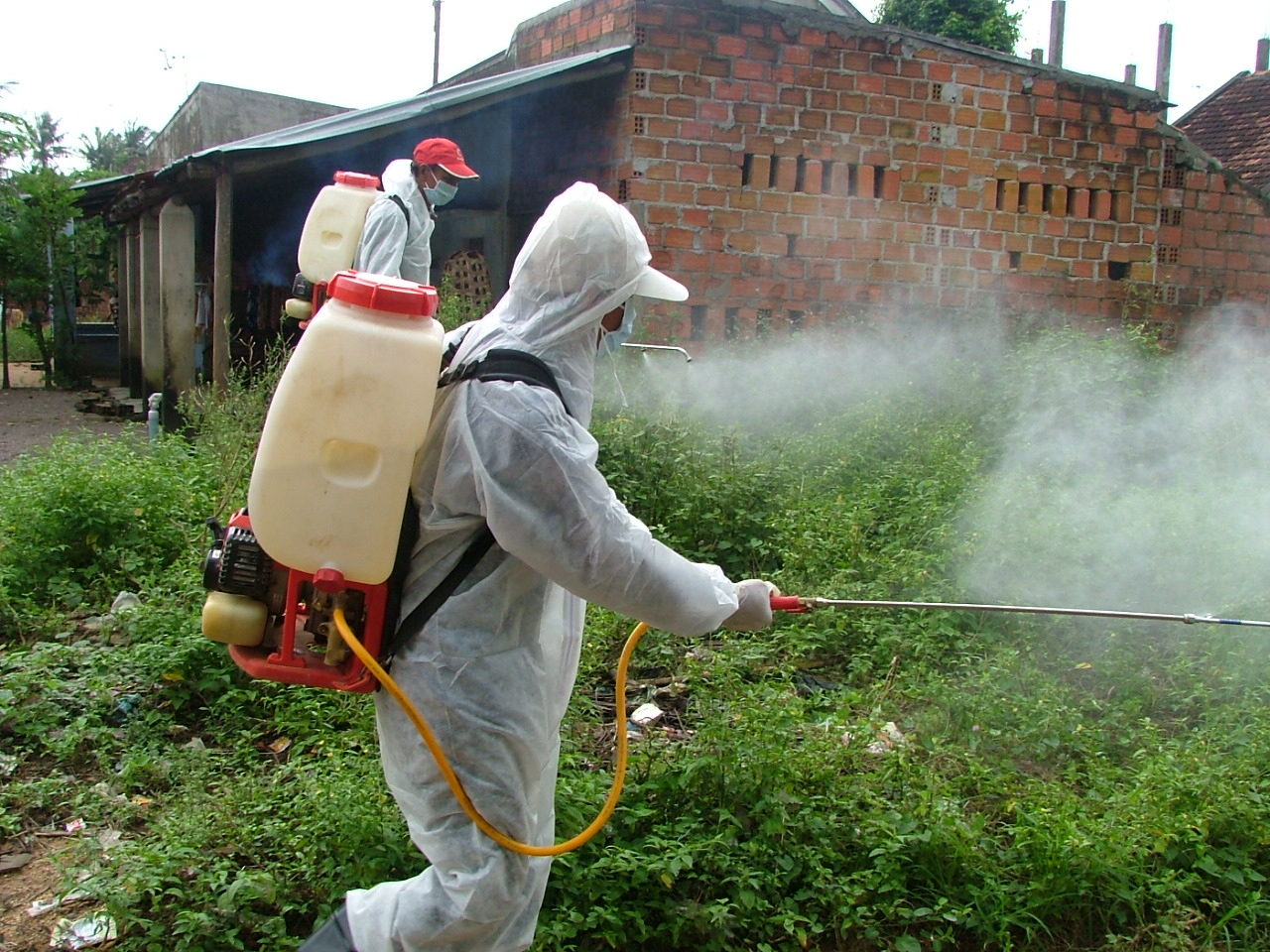June 13, 2025 | 07:19 GMT +7
June 13, 2025 | 07:19 GMT +7
Hotline: 0913.378.918
June 13, 2025 | 07:19 GMT +7
Hotline: 0913.378.918

Poultry farming households in Binh Dinh province performing regulated vaccinations. Photo: V.D.T.
Binh Dinh province has a poultry herd of over 9.6 million heads, an increase of 7.6% over the same period in 2022. According to Binh Dinh Sub-Department of Livestock Production and Animal Health, the avian flu epidemic is rapidly escalating within Vietnam and poultry flocks in neighboring provinces are infected with the disease. In addition, the weather conditions in Binh Dinh province is highly erratic with prolonged heatwaves and irregular rain, resulting high risk of diseases for the local poultry flocks.
The Ministry of Agriculture and Rural Development coordinated with Binh Dinh People's Committee to provide instructions on disease prevention in poultry flocks. Accordingly, the local government of Binh Dinh province has proactively implemented solutions to prevent epidemics, and rapidly deploy vaccinations in order to protect the local poultry flocks from diseases.
So far, the local government of Binh Dinh has deployed enclosed vaccination against avian influenza to ensure the vaccination rate for the entire flock, thereby limiting the risk of disease spreading from small flocks to large flocks.
In addition, Binh Dinh Sub-Department of Livestock Production and Animal Health has increased the frequency of active sampling surveillance in key livestock production areas, wholesale markets, and concentrated slaughterhouses in order to detect early signs of diseases for proactive prevention.

Binh Dinh Sub-Department of Livestock Production and Animal Health has increased the frequency of active surveillance sampling in concentrated slaughterhouses in order to detect the early signs of diseases for proactive prevention. Photo: V.D.T.
According to Mr. Huynh Ngoc Diep, Director of Binh Dinh Sub-Department of Livestock Production and Animal Health, vaccination and disease control activities for poultry flocks are strictly implemented by functional departments.
However, poultry flocks in Binh Dinh province are at a high risk of infection due to fluctuations in weather conditions. Additionally, the escalation of epidemics in neighboring provinces facilitates the spread of airborne pathogens. On the other hand, the illegal transportation of foreign poultry into Vietnam is increasingly common, which can bring avian influenza pathogens into Binh Dinh in particular.
“After receiving instructions from the Ministry of Agriculture and Rural Development, Binh Dinh People's Committee and the local Department of Agriculture and Rural Development directed the province's Sub-Department of Livestock Production and Animal Health to reinforce professional activities in epidemic prevention and control. Furthermore, the Sub-Department was requested to coordinate with local governments in disease inspection and control. Livestock production households will be guided in the regulated vaccination of poultry flocks," emphasized Mr. Huynh Ngoc Diep.

Farmers in Binh Dinh province disinfecting their barns to prevent disease. Photo: V.D.T.
In addition to maintaining a total herd of nearly 250,000 pigs, Hoai An district has focused on developing chicken farming within the past few years. The district recently utilized fruit farms on hilly land to develop chicken farming on hills. As a result, Hoai An district is also making an effort to actively prevent diseases in poultry.
According to Mr. Vo Duy Tin, Head of Hoai An district's Office of Agriculture and Rural Development, the total herd of livestock in the district remained relatively stable throughout the first six months of 2023 with 832,700 poultry, which is 106% of the district's plan.
In an effort of preventing diseases, the local government has actively vaccinated, disinfected and sterilized production areas. farmers receive consultation to take multiple measures to protect their livestock, including poultry, in the hot season. The animal health force deployed enclosed vaccines in accordance with local regulations.

There is a significant risk of disease spreading in poultry flocks when poultry are slaughtered haphazardly.. Photo: V.D.T.
The poultry flocks in Tay Son district have also been maintained at a stable level. Namely, there are currently 804,000 heads in the local poultry flock, which is 89% of the district's plan. The local government has promoted vaccination activities, and epidemics have been contained and controlled. According to Mr. Le Ha An, Head of Tay Son district's Office of Agriculture and Rural Development, the district will deploy vaccinations and supervise livestock activities in order to reduce the risk of disease spreading before the upcoming rainy season.
Due to the fluctuations in product selling prices and high feed prices, poultry farmers in Binh Dinh province have flexibly changed their livestock production methods to reduce input costs since the beginning of the year. The majority of major poultry farmers in Binh Dinh province are shifting towards bio-safe chickens and hill chicken production to fully utilize natural feed and agricultural by-products, thereby reducing the amount of industrial feed as well as product prices.
Translated by Nguyen Hai Long

(VAN) In Tien Giang, a high-tech shrimp farm has developed a distinctive energy-saving farming model that has yielded promising results.
![Turning wind and rain into action: [3] 300.000 farmers benefit from agro-climatic bulletins](https://t.ex-cdn.com/nongnghiepmoitruong.vn/608w/files/news/2025/06/12/e5a48259d6a262fc3bb3-nongnghiep-125122.jpg)
(VAN) The agro-climatic bulletin has become a valuable tool for farmers in the Mekong Delta. After more than five years of implementation, the initiative is gradually being expanded nationwide.
![Turning wind and rain into action: [2] Providing forecasts to the people](https://t.ex-cdn.com/nongnghiepmoitruong.vn/608w/files/news/2025/06/12/e5a48259d6a262fc3bb3-nongnghiep-103927.jpg)
(VAN) In addition to improving the quality of hydrometeorological forecasts, putting forecast bulletins into practical use is crucial for production and disaster prevention.

(VAN) Blue carbon is receiving attention for its rapid absorption capacity and vast potential. It represents a promising nature-based solution to respond to climate change.
/2025/06/11/3507-1-161904_583.jpg)
(VAN) Seagrass beds and coral reefs serve as 'cradles' that nurture life in the ocean depths, creating rich aquatic resources in Vietnamese waters.
![Turning wind and rain into action: [1] Forecasting for farmers](https://t.ex-cdn.com/nongnghiepmoitruong.vn/608w/files/news/2025/06/11/e5a48259d6a262fc3bb3-nongnghiep-111919.jpg)
(VAN) Weather is no longer just a matter of fate. Forecasts have now become an essential companion for farmers in every crop season.
/2025/06/10/2501-3-082025_983.jpg)
(VAN) Mr. Le Hoang Minh, Head of Vinamilk's Net Zero project, recently shared insights on the integration of production, energy, and technology in Vinamilk’s green transition journey.